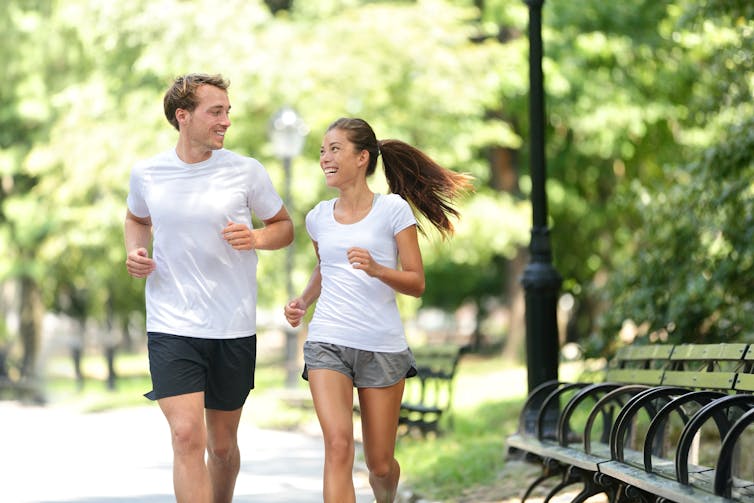When summer temperatures soar, the idea of working out might be the furthest thing from your mind. But just because it’s hot doesn’t mean you can’t still squeeze a workout in if you want to, though there are a few adjustments you may need to make to your normal routine.
In general, the elderly, children, pregnant women and people with underlying health conditions, are at greater risk and more susceptible to the adverse effects of heat stress. So these groups may want to give exercise a miss when the temperatures heat up. But even if you’re a generally healthy, active person, it’s still important to take caution if you decide to exercise.
When the stress of exercise and heat combine, a large strain is placed on our body in order to reduce body temperature. One of the most noticeable ways our body responds is through sweating which is an important part of our body’s primary cooling mechanism: evaporation. This is why our bodies sweat more when it’s hot outside or when we’re working out.
There’s also a greater demand on our cardiovascular system. When we exercise, our muscles need adequate blood flow in order to be able to continue moving. When it’s hot, the heart needs to work even harder to divert blood to the skin’s surface, where it’s cooled and returned for re-circulation.
This not only makes exercise feel harder on a hot day, but is why prolonged exercise in the heat can lead to dehydration. This can also make it harder for the heart, muscles and lungs to work properly as a result.
If you are thinking of exercising on a hot day, here are some of the best things you can do to beat the heat:
1. Stay hydrated
Make sure you’re hydrated before you even think about exercising. Pale yellow urine is typically the best way to tell if you’re hydrated well enough. During exercise, consume fluids in small amounts often, and keep them cool by leaving them in the shade or storing them in an insulated bottle.
You might also want to consider adding electrolyte tablets to your water. Not only do these improve taste, they also ensure essential minerals (including sodium and potassium) lost through sweat are replaced. Finally, make sure you re-hydrate after your workout with either cool water, a sports drink, or even a glass of milk, which offers protein and electrolytes.
2. Lower exercise intensity.
Start your workout gradually and lower your intensity to accommodate for the higher heart rate and increase in perceived exertion. Consider temporarily swapping your outdoor exercise for indoor activities too, such as an air-conditioned gym workout or swimming if you can.
3. Plan ahead
Pay attention to weather forecasts before you set off and complete your exercise in the early morning or late evening, when outdoor temperatures and solar heat are lower.
4. Dress appropriately
Wear loose-fitting, light-coloured and breathable clothing so that your sweat can evaporate more easily, helping your body cool. Take a hat and sunglasses, too. Importantly apply strong, water resistant sun cream (at least SPF 30 or above) 30 minutes before starting to avoid sunburn.

5. Change it up
Avoid exercising in urban areas if you can. Seek a cooler place to workout that offers green space, shade and even surrounding water. If running, do so in loops to enable cool drinks can be left at convenient places to re-hydrate. You might also want to consider working out with a friend so you can both keep an eye on each other.
6. Combine cooling methods
Use both internal (such as eating an ice pop or drinking cold water) and external (such as wearing an ice vest or cold towel) cooling methods before, during and after a workout. Running your hands, forearms and feet under cold water is also effective at reducing temperature. But nothing beats a cold shower – or even an ice bath – before and after exercising.
7. Listen to your body
Heat illness can be life threatening so it’s important to be as cautious as possible when exercising on a hot day. Keep an eye on your heart rate and listen to how your body feels. Symptoms of heat illness include headache, dizziness, confusion, excess sweating, muscle cramps (including in the stomach), sickness, severe fatigue and unusually heavy breathing or high heart rate. Listen to your body, modify your workout and stop if you’re not feeling well.
The body does however responds surprisingly quickly to the heat. After five to ten days of exercising in hot temperatures, your body is better able to handle it and you may have a lower risk of heat illness. That being said, it’s still important to use common sense if you decide to exercise during hot weather, by modifying your workout and listening to your body.
If you think you have heat illness, try to cool your body down as fast as possible by immersing or dousing in cool water or fanning yourself off in the shade. Emergency support should be sought if it’s serious.
Ash Willmott, Senior Lecturer in Sport and Exercise Science, Anglia Ruskin University; Justin Roberts, Associate Professor, Health and Exercise Nutrition, Anglia Ruskin University, and Oliver Gibson, Senior lecturer, Exercise and Environmental Physiology, Brunel University London
This article is republished from The Conversation under a Creative Commons license. Read the original article.

